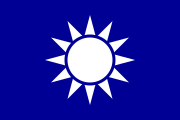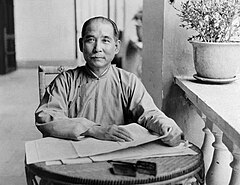Pan-Blue Coalition
Pan-Blue Coalition Phiếm lam liên minh | |
|---|---|
 | |
| Leader | Eric Chu |
| Ideology | |
| Political position | Centre-righttoright-wing |
| Colours | Blue |
| Legislative Yuan | 54 / 113 (48%) |
| Pan-Blue coalition | |||||||||||||||||||
|---|---|---|---|---|---|---|---|---|---|---|---|---|---|---|---|---|---|---|---|
| Traditional Chinese | Phiếm lam liên minh | ||||||||||||||||||
| Simplified Chinese | Phiếm lam liên minh | ||||||||||||||||||
| |||||||||||||||||||
| Pan-Blue force | |||||||||||||||||||
| Traditional Chinese | Phiếm lam quân | ||||||||||||||||||
| Simplified Chinese | Phiếm lam quân | ||||||||||||||||||
| |||||||||||||||||||
| Pan-Blue groups | |||||||||||||||||||
| Traditional Chinese | Lam doanh | ||||||||||||||||||
| Simplified Chinese | Lam doanh | ||||||||||||||||||
| |||||||||||||||||||
| Part ofa serieson |
| Conservatism in China |
|---|
| Part ofa serieson |
| Three Principles of the People |
|---|
 |
Thepan-Blue coalition,pan-Blue forceorpan-Blue groupsis apolitical coalitionin theRepublic of China (Taiwan)consisting of theKuomintang(KMT),People First Party(PFP),New Party(CNP),Non-Partisan Solidarity Union(NPSU), andYoung China Party(YCP). The name comes from the party color of the Kuomintang.
Regarding thepolitical status of Taiwan,this coalition maintains that the Republic of China instead of thePeople's Republic of Chinais the legitimate government of China, favors a Chinese and Taiwanese dual identity over an exclusive Taiwanese identity, and favors greater friendly exchange withMainland China,as opposed to thePan-Green Coalition.
Political stance
[edit]The Pan-Blue Coalition's political stance can be characterized as centre-right,[2]conservatismand Republic of China-centeredChinese nationalism.
Originally, the Pan-Blue Coalition was associated withChinese unification,but has moved towards a more conservative position supporting the presentstatus quo,while rejecting immediate unification with mainland China. It now argues that reunification is possible only after thecommunist regimein mainland China collapses or transitions to ademocracyeither as a new democratic government or with the re-establishment ofSun Yat-sen's Republic of China government which fled toTaiwanafter theChinese Civil War.This would also allow the body ofChiang Kai-shekto be returned to his ancestral home inXikou.[citation needed]
History
[edit]Lee Teng-hui presidency: 1988–2000
[edit]Throughout the 1990s, the Kuomintang (KMT) consisted of an uneasy relationship between those party members who had mainland China backgrounds (came from mainland China in 1949) and Taiwanese political elites, Taiwanese factions led by PresidentLee Teng-hui,who supported a strongerTaiwanese identityand distinction fromChinese nationalism.Lee won the party control after theindirect election in 1990.This led to a split in the early 1990s, when theNew Partywas formed by the anti-Lee dissidents in the KMT. After the dissidents of KMT members left, the KMT remained loyal and with control by President Lee Teng-hui throughout his presidency.[citation needed]
During the2000 presidential election,Lee Teng-hui arranged forLien Chanto be nominated as Kuomintang candidate for president rather than the more popularJames Soong,who left the party and formed his ownPeople First Partyafter both he and Lien were defeated byChen Shui-bianin the presidential elections. Though Chen and the DPP won the presidency, pro-KMT lawmakers held 140 out of 225 seats in theLegislative Yuan.Soong and Lien later formed a coalition in opposition to the DPPminority government.[citation needed]
First time in opposition: 2000–2008
[edit]In the 2000 presidential election itself, the split in Kuomintang votes between Soong and Lien led in part to the election of Chen Shui-bian. After the election, there was widespread anger within the Kuomintang against Lee Teng-hui, who was expelled for forming his own pro-Taiwan independenceparty, theTaiwan Solidarity Union.[3]After Lee's expulsion, the Kuomintang moved its policies back to a more conservative one and began informal but close cooperation with the People First Party and theNew Party.This coalition became informally known as the Pan-Blue Coalition. Although the members of the Pan-Blue Coalition maintain separate party structures, they closely cooperate in large part to ensure that electoral strategies are coordinated, so that votes are not split among them leading to a victory by the Pan-Green Coalition.[citation needed]
The KMT and PFP ran a combined ticket in the2004 presidential electionswith Lien Chan running for president and James Soong running for vice president. The campaign emblem for the Lien-Soong campaign was a two-seat bicycle with a blue (the color of the KMT) figure in the first seat and an orange (the color of the PFP) figure in the second.[citation needed]
There were talks in late 2004 that the KMT and the PFP would merge into one party in 2005, but these talks have been put on hold. In the2004 legislative electionthe three parties from the pan-blue coalition organized themselves to properly divide up the votes (Xứng phiếu) to prevent splitting the vote. The New Party ran all but one of its candidates under the KMT banner. The result was that the KMT gained 11 more seats and the PFP lost 12 seats. Right after the election, PFP chairman James Soong began criticizing the KMT for sacrificing the PFP for its own gains and stated that he would not participate in any negotiations regarding to the two parties' merge. Soong's remarks have been strongly criticized by the KMT, a majority of PFP members, and the New Party, whose rank and file were largely absorbed by the PFP following the 2001 elections. Nonetheless, shortly after the legislative election, the PFP legislative caucus agreed to cooperate with the DPP over the investigation into the KMT's finances. On 24 February 2005, James Soong met with President Chen for the first time in four years and issued a 10-point declaration[4]supporting the name "Republic of China", the status quo incross-strait relations,and the opening of theThree Links.Unlike Soong, Lien did not respond to the offer from Chen to meet.[citation needed]
However, after the2005 Pan-Blue visits to mainland China,Soong and Chen stopped their partnership. The popularTaipeimayorMa Ying-jeouwas also elected the new head of theKuomintang,and was considered the leading contender for the KMT nomination in the2008 presidential election.However, it was uncertain whether the KMT and PFP could agree to field a common ticket. On the2005 chairmanship election,Soong had made a televised endorsement of Ma's opponentWang Jin-pyng.[citation needed]
In theDecember 2005 3-in-1 local elections,the KMT made large gains and held 14 seats, the DPP suffered defeat and held only six, the PFP retained only one, and the TSU was completely shut out. Ma Ying-jeou was now virtually assured of leading the KMT and pan-blues for the2008 presidential election.[citation needed]
Ma Ying-jeou presidency: 2008–2016
[edit]In the2008 legislative election,the coalition won 86 of 113 seats in theLegislative Yuan,giving it thesupermajorityneeded to recall the president and pass constitutional amendments for a referendum. The KMT, PFP, and NP coordinated their candidate lists in the new single-member constituency system. Candidates of theNon-Partisan Solidarity Union,who despite their party's official stance of non-affiliation, were deemed sympathetic to the coalition and ran unopposed by other blue candidates in almost all the seats it contested. The PFP ran almost all of their candidates under the KMT banner, with some placed under the KMT party list. While having all its district candidates run under the KMT banner, the New Party ran its own party list but failed to gain the 5% threshold for representation. The Kuomintang controlled the Legislative Yuan during theMa Ying-jeoupresidency from 2008 to 2016.[citation needed]
Second time in opposition: 2016–present
[edit]In2016 general election,the KMT lost the presidential election and, for the first time in the history of the Republic of China, the control in the Legislative Yuan.[5][6]TheDemocratic Progressive Party(DPP) took control of the legislature for the first time, winning the presidency. The KMT became the largest opposition party. The PFP's leaderJames Soong,despite being a member of the coalition, cooperated withTsai Ing-wen's administration, becoming the representative ofChinese Taipeiin theAPEC summit.[citation needed]
Member parties
[edit]Current members
[edit]| Party | Ideology | Leader | |
|---|---|---|---|
| Kuomintang(KMT) | Conservatism | Eric Chu | |
| New Party(NP) | National conservatism | Wu Cherng-dean | |
| People First Party(PFP) | Liberal conservatism | James Soong | |
| Non-Partisan Solidarity Union(NPSU) | Conservative liberalism | Lin Pin-kuan | |
Legislative strength
[edit]| Term | Member Party Seats | KMT Seats | NP Seats | PFP Seats | NPSU Seats | |
|---|---|---|---|---|---|---|
| 1st(1992) | 95 / 130
|
95 / 95
|
- | - | - | |
| 2nd | 95 / 162
|
95 / 95
|
- | - | - | |
| 3rd | 106 / 164
|
85 / 106
|
21 / 106
|
- | - | |
| 4th | 134 / 225
|
123 / 134
|
11 / 134
|
- | - | |
| 5th | 115 / 225
|
68 / 115
|
1 / 115
|
46 / 115
|
- | |
| 6th | 120 / 225
|
79 / 120
|
1 / 120
|
34 / 120
|
6 / 120
| |
| 7th | 85 / 113
|
81 / 85
|
- | 1 / 85
|
3 / 85
| |
| 8th | 69 / 113
|
64 / 69
|
- | 3 / 69
|
2 / 69
| |
| 9th | 39 / 113
|
35 / 39
|
- | 3 / 39
|
1 / 39
| |
| 10th | 40 / 113
|
40 / 40 [a]
|
- | - | - | |
| 11th | 54 / 113
|
54 / 54 [a]
|
- | - | - |
Media
[edit]See also
[edit]- History of the Republic of China
- Chinese nationalism in Taiwan
- One nation, two states
- Pan-Green Coalition
- Pan-Purple Coalition
- Pro-ROC camp
Explanatory notes
[edit]References
[edit]- ^"Chín nhị chung nhận thức Pura tư ( thượng ): Quốc dân đảng bên trong từng đề qua “Hoa độc”, vì sao cuối cùng không có chọn dùng? ".The News Lens(in Chinese). 27 April 2021.Retrieved15 February2024.
- ^M. Troy Burnett, ed. (2020).Nationalism Today: Extreme Political Movements around the World [2 volumes].ABC-CLIO.p. 201.ISBN9781440850004.
The center-right Pan-Blue Coalition, led by the KMT, maintains that the ROC is the sole legitimate government for all of China (including Taiwan) and that the aim of the government should be the eventual reunification of the mainland...
- ^"KMT breaks it off with Lee Teng-hui - Taipei Times".Taipei Times.2001-09-22.Retrieved2020-05-24.
- ^"e-Government Website/Homapage".23 February 2005. Archived fromthe originalon 23 February 2005.
- ^"Tsai Ing-wen wins Taiwan leadership election[1]- Chinadaily.cn".China Daily.Retrieved2020-05-24.
- ^"ELECTIONS: Chu concedes, resigns as KMT chair".Taipei Times.2016-01-17.
External links
[edit]- Kuomintang – Official website( Trung Quốc quốc dân đảng, Zhōngguó Guómín Dǎng)
- People First Party – Official website( thân dân đảng, Qīnmín Dǎng)
- New Party – Official website( tân đảng, Xīn Dăng)

